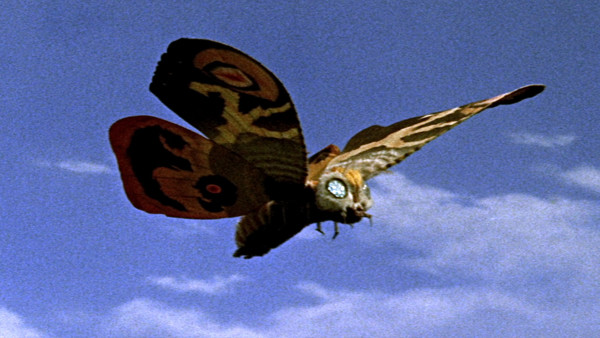
Japan Society returns with its Summer Series, that includes an iconic film of the Sixties directed by Ishirō Honda: Mothra.
This kaijū (strange beast), first appeared in the movie produced and distributed by Toho Studios, and was later featured in several Toho tokusatsu films, especially in the Godzilla franchise. The story originates from the serialised novel The Luminous Fairies and Mothra, penned by authors Shinichiro Nakamura, Takehiko Fukunaga and Yoshie Hotta, and was later adapted by screenwriter Shinichi Sekizawa into a screenplay. The motion picture boasted some remarkable special effects for its era, realised by Eiji Tsuburaya.
The cinematic narrative begins with a scientific expedition on the radiation-laden Infant Island, carried out by a team of Japanese and Rolisicans. The explorers discover a paradise of mutated species and hidden glyphs. Among them is a pair of tiny twin fairies (played by pop duo The Peanuts — Emi and Yumi Ito), who sing Mothra’s Song that became ingrained into popular culture.
In this first adventure, Mothra’s mission is to save the magical twin priestesses, who have been kidnapped by the unscrupulous businessman Clark Nelson (Jerry Ito). For one evil human there are other kind-hearted ones — like photographer Michi Hanamura played by Kyôko Kagawa — who help the island’s mythical deities reunite with Mothra to return home, safe from the dangers of the civilised world.
The themes in this sci-fiction resonate stronger than ever. When it was first released in 1961, Mothra conveyed the feeling of nuclear anxiety which is still present today. This is blatant through the way the Rolisica (an amalgam of Russia and America) is portrayed as a “pushy capitalist superpower.” These forces have never ceased to march against each other to hold control on the world’s geopolitics, as the current situation with Ukraine has brought to light.
The film is all about enlightenment. In fact, the name of the gigantic creature is indicative of its allegorical transformation. “Mothra” — Mosura in Japanese — comes from the word “Moth” and “ra” is a whale-sized suffix. This being begins its life-cycle as a giant brown larva, to emerge as a giant moth. Mosura, still in a larval state, is telepathically invoked by the fairies who summon her by chanting their holy hymns. Upon reaching the Nipponic metropolis, Mothra involuntarily tears down a series of skyscrapers as she passes. The deployment of forces arranged by the army does not suffice to stop her incubation process: the larva places itself on the Tokyo Tower to spin the cocoon and rise again as a rainbow moth. Her physical metamorphosis is a clear analogy for the mutation of the states of consciousness: the awareness achieved when shifting from knowing something on the surface to undergoing a deep experience that leads to a whole new capacity and perception.
This inspirational creature has been featured in many other cinematic tales, from the 1964 Mothra vs. Godzilla all the way up to the 2019 Godzilla: King of the Monsters. Over fifteen films have tributed this character, not to mention the world of television, video games and literature.
Whilst other monsters epitomise strength and destruction, Mothra represents the end of conflict. Although she’s a fighter, her plight is to restore peace no matter what. She embodies Mother Nature (it is no coincidence that the international name Mothra has an assonance with the word “mother”), and in her filmic representation the ecological metaphor is undoubtably explicit. Throughout her appearances, subsequent to the first film, Mothra becomes the symbol of the good kaijū, intervening whenever the biophysical balance of the Earth is in danger, quickly becoming the sworn enemy of Gojira-Godzilla (pollution par excellence). This is why Mothra is also known as the “Queen of Monsters,” because she has a sense of protection towards the tiny living things that streak our planet’s surface, that are thusly more vulnerable.
Mothra will screen at Japan Society on July 8th at 7pm, with an introduction by Japanese sci-fi critic Kevin Derendorf.

